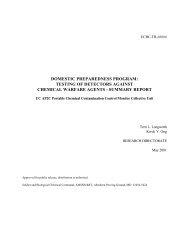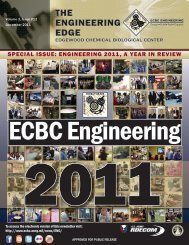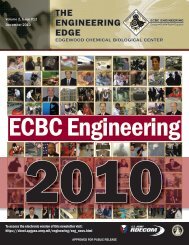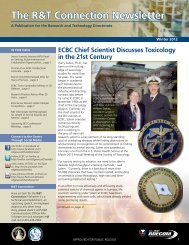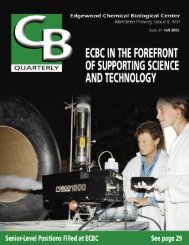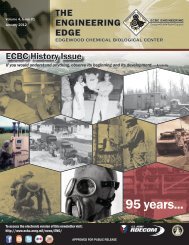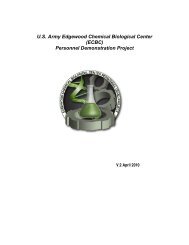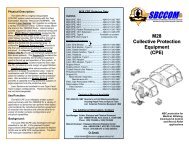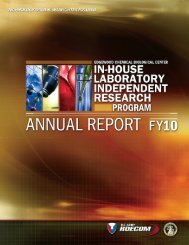(FFPE) with Self-Contained Breathing Apparatus (SCBA) for Rescue
(FFPE) with Self-Contained Breathing Apparatus (SCBA) for Rescue
(FFPE) with Self-Contained Breathing Apparatus (SCBA) for Rescue
Create successful ePaper yourself
Turn your PDF publications into a flip-book with our unique Google optimized e-Paper software.
Warning: Take special care to avoid contaminating footwear and clothing <strong>with</strong> liquid chemical<br />
agent. Skin contact <strong>with</strong> liquid chemical agent dosage may be lethal. Liquid contamination is<br />
very easy to spread. Spread liquid contamination will “offgas” highly toxic vapors and continues<br />
as a skin contact hazard.<br />
4) Without <strong>Rescue</strong> in Conjunction <strong>with</strong> Recon - If no living victims are seen, then leave the<br />
building immediately, seal and secure the building, and wait <strong>for</strong> the arrival of HAZMAT<br />
responders, who are appropriately equipped <strong>with</strong> CBRN-certified protective ensembles (Level A<br />
suits).<br />
Victim In<strong>for</strong>mation:<br />
Location: Are casualties visible near an entrance Are they in the line-of-sight Can they be<br />
heard Estimate how long it would take to reach and remove them.<br />
Number: If there are enough HAZMAT responders equipped <strong>with</strong> CBRN-certified protective<br />
ensembles (Level A suits) available to rescue live victims in a timely manner, use them.<br />
Otherwise, consider using personnel who are wearing alternative ensembles (i.e. turnout gear<br />
<strong>with</strong> <strong>SCBA</strong>), as approved by the Incident Commander.<br />
Condition: Are casualties ambulatory or non-ambulatory Signs and symptoms Traumatic<br />
injuries Entanglement Mental state<br />
<strong>Rescue</strong> and Standby Teams: Select at least two personnel per team <strong>with</strong> appropriate personal<br />
protection. Ensure they are hydrated.<br />
Chemical Agent Hazard Reduction: Consider use of positive pressure ventilation (PPV) fans or<br />
other fans to reduce or redirect vapor or aerosol concentration. Be sure that use of these fans will<br />
not spread chemical agent to endanger other people. If fans are acceptable, they should be<br />
placed in service while rescuers are donning their protective ensemble.<br />
Review In<strong>for</strong>mation about Chemical Warfare Agents (CWA): The higher the vapor pressure of a<br />
CWA, the higher its rate of evaporation (volatility). Temperature and humidity can affect CWA<br />
properties and exposure risk.<br />
<strong>SCBA</strong> (positive pressure): <strong>SCBA</strong> must be used <strong>for</strong> all rescue missions. <strong>SCBA</strong> should be<br />
certified under the NIOSH CBRN <strong>SCBA</strong> standard <strong>for</strong> use in a chemical agent environment.<br />
Personal Protective Ensemble (PPE): <strong>Rescue</strong> personnel must wear as a minimum standard<br />
complete turnout gear <strong>with</strong> <strong>SCBA</strong>. This ensemble must consist of a protective garments,<br />
helmets, hoods, gloves, and footwear that has been certified to NFPA 1971, Standard on<br />
Protective Ensemble <strong>for</strong> Structural Fire Fighting, that has been properly maintained and is free<br />
from damage and self-contained breathing apparatus (<strong>SCBA</strong>) that is certified to NFPA 1981,<br />
Standard on Open-Circuit, <strong>Self</strong>-<strong>Contained</strong> <strong>Breathing</strong> <strong>Apparatus</strong>.<br />
<strong>Rescue</strong> Team Exposure Time: Limit the initial exposure time to no more than 30 minutes. In all<br />
cases, on-scene exposure times must be minimized, wherever possible. No entry team will reenter<br />
the contaminated area unless authorized and extreme circumstances clearly warrant doing<br />
D-3



